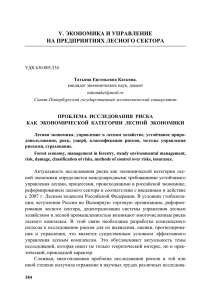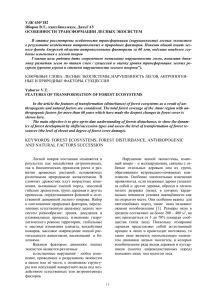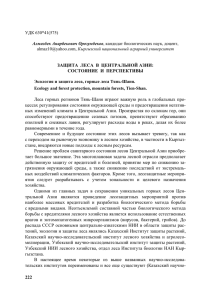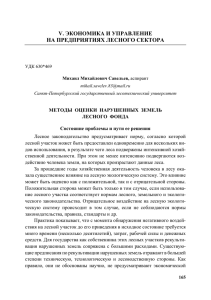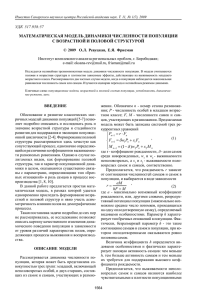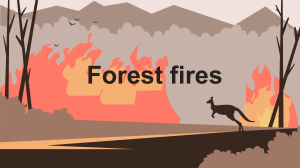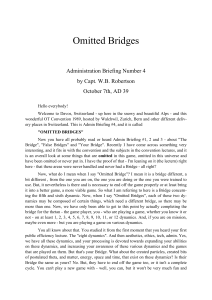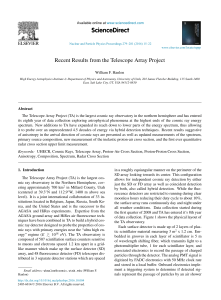НОВЫЕ ВЫЗОВЫ И ТЕНДЕНЦИИ В ЗАЩИТЕ ЛЕСА
реклама
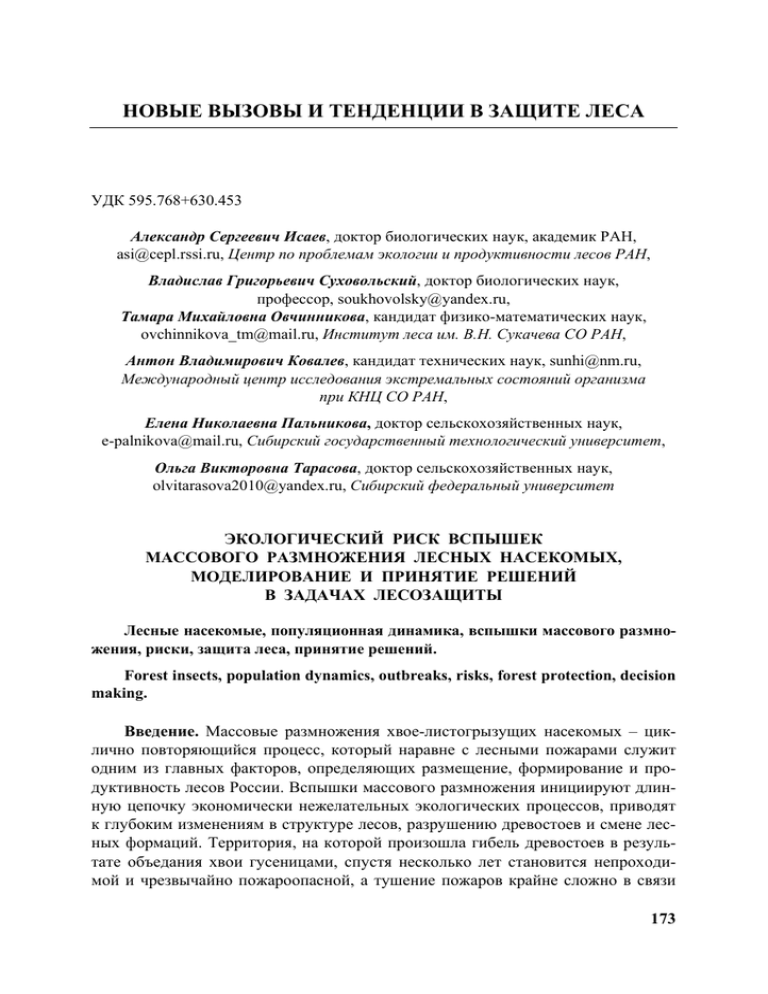
ɇɈȼɕȿ ȼɕɁɈȼɕ ɂ ɌȿɇȾȿɇɐɂɂ ȼ ɁȺɓɂɌȿ ɅȿɋȺ 595.768+630.453 Ⱥɥɟɤɫɚɧɞɪ ɋɟɪɝɟɟɜɢɱ ɂɫɚɟɜ, , , asi@cepl.rssi.ru, ɐɟɧɬɪ ɩɨ ɩɪɨɛɥɟɦɚɦ ɷɤɨɥɨɝɢɢ ɢ ɩɪɨɞɭɤɬɢɜɧɨɫɬɢ ɥɟɫɨɜ ɊȺɇ, ȼɥɚɞɢɫɥɚɜ Ƚɪɢɝɨɪɶɟɜɢɱ ɋɭɯɨɜɨɥɶɫɤɢɣ, , , soukhovolsky@yandex.ru, Ɍɚɦɚɪɚ Ɇɢɯɚɣɥɨɜɧɚ Ɉɜɱɢɧɧɢɤɨɜɚ, ovchinnikova_tm@mail.ru, ɂɧɫɬɢɬɭɬ ɥɟɫɚ ɢɦ. ȼ.ɇ. ɋɭɤɚɱɟɜɚ ɋɈ ɊȺɇ, , Ⱥɧɬɨɧ ȼɥɚɞɢɦɢɪɨɜɢɱ Ʉɨɜɚɥɟɜ, , sunhi@nm.ru, Ɇɟɠɞɭɧɚɪɨɞɧɵɣ ɰɟɧɬɪ ɢɫɫɥɟɞɨɜɚɧɢɹ ɷɤɫɬɪɟɦɚɥɶɧɵɯ ɫɨɫɬɨɹɧɢɣ ɨɪɝɚɧɢɡɦɚ ɩɪɢ Ʉɇɐ ɋɈ ɊȺɇ, ȿɥɟɧɚ ɇɢɤɨɥɚɟɜɧɚ ɉɚɥɶɧɢɤɨɜɚ, , e-palnikova@mail.ru, ɋɢɛɢɪɫɤɢɣ ɝɨɫɭɞɚɪɫɬɜɟɧɧɵɣ ɬɟɯɧɨɥɨɝɢɱɟɫɤɢɣ ɭɧɢɜɟɪɫɢɬɟɬ, Ɉɥɶɝɚ ȼɢɤɬɨɪɨɜɧɚ Ɍɚɪɚɫɨɜɚ, , olvitarasova2010@yandex.ru, ɋɢɛɢɪɫɤɢɣ ɮɟɞɟɪɚɥɶɧɵɣ ɭɧɢɜɟɪɫɢɬɟɬ ɗɄɈɅɈȽɂɑȿɋɄɂɃ ɊɂɋɄ ȼɋɉɕɒȿɄ ɆȺɋɋɈȼɈȽɈ ɊȺɁɆɇɈɀȿɇɂə Ʌȿɋɇɕɏ ɇȺɋȿɄɈɆɕɏ, ɆɈȾȿɅɂɊɈȼȺɇɂȿ ɂ ɉɊɂɇəɌɂȿ ɊȿɒȿɇɂɃ ȼ ɁȺȾȺɑȺɏ ɅȿɋɈɁȺɓɂɌɕ Ʌɟɫɧɵɟ ɧɚɫɟɤɨɦɵɟ, ɩɨɩɭɥɹɰɢɨɧɧɚɹ ɞɢɧɚɦɢɤɚ, ɜɫɩɵɲɤɢ ɦɚɫɫɨɜɨɝɨ ɪɚɡɦɧɨɠɟɧɢɹ, ɪɢɫɤɢ, ɡɚɳɢɬɚ ɥɟɫɚ, ɩɪɢɧɹɬɢɟ ɪɟɲɟɧɢɣ. Forest insects, population dynamics, outbreaks, risks, forest protection, decision making. ȼɜɟɞɟɧɢɟ. - – - , , , - . , , . , , - , 173 , , , . , , . . [1–3]. - , , - – . , – , - . . - , , - , . , ; - . Ɇɟɬɨɞɵ ɦɨɞɟɥɢɪɨɜɚɧɢɹ ɩɨɩɭɥɹɰɢɨɧɧɨɣ ɞɢɧɚɦɢɤɢ ɧɚɫɟɤɨɦɵɯ. , [4, 5]. » - « : - ( ), , , . – - [6]. . - , , , . 174 - , : G G0 a ( X X r )q 2 bq 4 G – (1) , ;q– , ( ;X– ; G0, a, b – (1) ), ; Xr – . ( . 1). q2 1 q2 = –0,0014 X + 0,921 R2 = 0,807 0,8 0,6 0,4 0,2 0 0 1000 2000 3000 ɏ, 4000 5000 ./ Ɋɢɫ. 1. [7] (ɏ – ,q– ) Xr , 660 [8]. 0,921 657 0,0014 , - . Xr , - . 175 Ɉɰɟɧɤɢ ɪɚɡɦɟɪɨɜ ɨɱɚɝɨɜ ɦɚɫɫɨɜɨɝɨ ɪɚɡɦɧɨɠɟɧɢɹ ɧɚɫɟɤɨɦɵɯ , . , . ɏ – , S. S0 - ( [4]. ( X0 ), - ), , , , S X– - , – ( , ). , . » ) ( « dX dt kX ( A X )( X B) cXS dS mX bS , dt , - : (2) T1 1 T2 Ɍ1 Ɍ2 ;k– , B– ,ɫ– b– ,A ,– , ,m . , (2) . . . 176 (2) - , – . .2 - (2). S 1 2 s0 sr 3 0 Ɋɢɫ. 2. xout xr x0 - xmax « ɏ ( S( » ; ɏ0 – X (3) ) ). S0, Sr – , - ; Xr – ; Xmax – , Xout – [5] « S m b m X b . - (2) , 1 m b (2) .2 ». .2 , , ɏ0, (2) - S 0. , , . , , 177 Sr , [9]. « » « » - , . ɏr Ɍ1) « », Smax, ( Xmax. . 2, m b X = Xmax , 1, Smax Xmax ( , S = Smax (2) - - ). [4]. , ɏout , , , [4]. S0 ɏ0 . (2), (ɏr – ɏ0) , ɏr . , , , , . m ( b - (2) 2 (2) . 2). – . . . m b , (3) 3 . 2, [4]. « - , , 178 [10]. », . . - (« « » ) - » : X dX dt kX ( A X )( X B) c S d (1 / S ) b 1 mX . dt S (3) « - (3) , » 1 S (2). (3) . 3. 4 5 1 s0 1 sr 6 0 xr x0 Ɋɢɫ. 3. xout - « – 1/S ( m b ɏ0 (3) ( X » (4) ɏ ) S– 1 m X S b , 4 . 3), S0 ( 1/S0 ). S . ɏ 1 1 ) S Sr - xm « , Sr ( - », - 179 Ɍ 1, ( ɏmax (2)) Sr m b , - ɏ = Xout , , ɏ = ɏ0 ( - . 6 S = S 0. m b ( , . . 5 . 3) - . 3). , X ( X r X 0 ) S ( S r S0 ) , « « S, » » (2) (3). - , . - . ɉɪɢɧɰɢɩɵ ɩɨɫɬɪɨɟɧɢɹ ɫɢɫɬɟɦɵ ɩɨɞɞɟɪɠɤɢ ɩɪɢɧɹɬɢɹ ɪɟɲɟɧɢɣ ɩɪɢ ɜɵɛɨɪɟ ɜɨɡɞɟɣɫɬɜɢɹ ɧɚ ɩɨɩɭɥɹɰɢɢ ɜɪɟɞɢɬɟɥɟɣ - t0 p (t0 ) – , . 180 R (t0 ) p(t0 ) W (t0 ) R(t0): (4) t0 ; W (t0 ) – ;– « » - , - - . , – . . 4. t=0 М я я П t=t+1 R(t) R(t)>R(0) t=t+1 П - я П я. П я - З ? Ɋɢɫ. 4. .4 , . , , , – , . . , - . – R(t), R0 181 , , - - – , . « » – « , - », . ( ) ( ) , - , ( ), - . - , R0 , , , - ( ) ( - ), ( - , , ). 11-04-00176- . Ȼɢɛɥɢɨɝɪɚɮɢɱɟɫɤɢɣ ɫɩɢɫɨɤ 1. Ȼɚɪɚɧɱɢɤɨɜ, ɘ.ɇ. : . [ ]/ . . , 2004. – . 256–258. 2. Ȼɚɪɚɧɱɢɤɨɜ, ɘ.ɇ. // . . . .: . . . , 2004. – . 32–53. 3. ɋɟɥɢɯɨɜɤɢɧ, Ⱥ.ȼ. , [ . . . ]/ .– . . 182 . – 2009. – . 1, № 1. – C. 72–81. : , ?[ // - - . . ]/ . . - .– – - 4. ɂɫɚɟɜ, Ⱥ.ɋ. [ ]/ . . , , . . , . . , . . , . . .– . – 2001. – 374 . 5. Isaev, A.S. Forest insects population dynamics [Text] / A.S. Isaev, R.G. Khlebopros, V.V. Kiselev, Yu.P. Kondakov, L.V. Nedorezov, V.G. Soukhovolsky. – : , – 2009. – 115 . 6. ɋɭɯɨɜɨɥɶɫɤɢɣ, ȼ.Ƚ. [ ] / . . , . . , . . , . . // . – 2005. – . 403, № 4. – . 551–553. 7. Ʉɨɧɞɚɤɨɜ, ɘ.ɉ. [ ]/ . . // .– : , 1974. – . 206–265. 8. ɂɥɶɢɧɫɤɢɣ, Ⱥ.ɂ. , [ ]/ . . ; . . . .– .: . - , 1965. – 525 . 9. Ȼɟɪɟɡɨɜɫɤɚɹ, Ɏ.ɋ. [ ] / . . , . . , . . , . . // , 1999. – . 365, № 3. – . 416–419. 10. Ɍɚɪɚɫɨɜɚ, Ɉ.ȼ. : [ ]/ . . , . . , . . , . . .– : , 2004. – 180 . . . .: - – - , , , - . , - , , . . - , . , . , – . 183 , , , , - . *** Insects’ outbreaks are cyclic iterative processes. Outbreaks and forest fires are major factors in determining location, formation and productivity of Russian forests. It is necessary to develop and put into practice new effective forest protection methods of insect pests density estimation, assessing the impact of external factors on the insects, modeling and prediction of population dynamics, new methods of decision-making in the planning of forest protection to prevent and minimize damage from insects impacts. It is proposed to use methods of the phenomenological theory of population dynamics and model of outbreaks as a phase transition for estimation of critical population density. It is possible to calculate the critical density of populations of several species of insect by using the proposed approaches. The models of outbreaks spatial dynamics are proposed that take into account the ratio of characteristic times of changes in the outbreak’s area and pest population density. We propose a population-energy model of the interaction of insects with food and introduce the notion of ecological food prices, a price and withdrawal price of food consumption and prices are given for assessing the environmental food for insect populations at different stages of the outbreak to model food consumption and insect damage forecast of plantation. We consider the general scheme of decision-making process in planning and implementing protective measures. This scheme includes an assessment of the current state of the pest population and its associated ecosystem components, prediction of environmental risk, the choice of the optimal scenario of protection activities, forecast and evaluate the effectiveness of protective measures. 184
